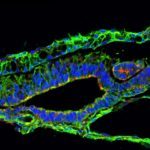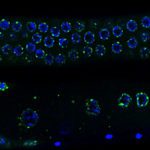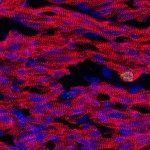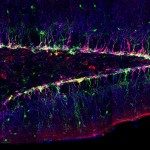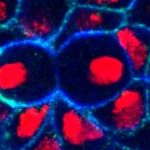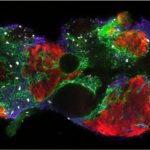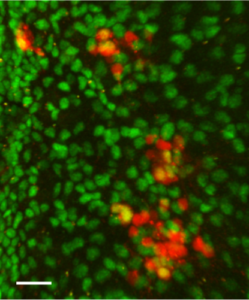 Tracking the neural stem cell subtypes in vivo
Tracking the neural stem cell subtypes in vivo
We combined intravital imaging, genetic tracing in vivo and biophysical modeling in the adult zebrafish to quantitatively characterize brain neural stem cell dynamics during adult life. We demonstrated that neural stem cell maintenance relies on a hierarchy of sub-functionalized stem cells, whose individual fates are balanced at the population level.
Legend: Whole-mount dorsal view of an adult zebrafish telencephalon showing part of the NSC population (green nuclei) and NSC-derived clones (red) genetically traced for 3 months. These clones contain NSCs (yellow) and neurons (red only). Scale bar: 20µm
Lineage hierarchies and stochasticity ensure the long-term maintenance of adult neural stem cells, Sci Adv, 2020 May.
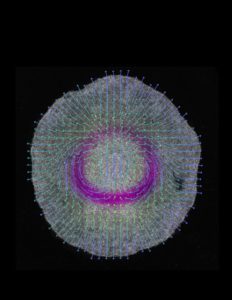 The embryo shaped by a contractile ring during gastrulation
The embryo shaped by a contractile ring during gastrulation
Gastrulation is an essential step in development in which the internal tissues of the body are set apart. In birds and mammals, a similar cascade of molecular events is known to specify embryonic territories, but how they are physically remodeled has remained elusive. Working with avian embryos, Saadaoui et al. identified a cable that encircles the embryo as the engine of gastrulation and described the collective cell movements as similar to the motion of a fluid. One side of this contractile ring pulls more strongly than the other, entraining the large-scale tissue movements that shape the early body plan. The embryo margin, previously known to function in molecular regulation, thus emerges as a dual mechanical and molecular organizer of development.
A tensile ring drives tissue flows to shape the gastrulating amniote embryo, Science, 2020 Jan.
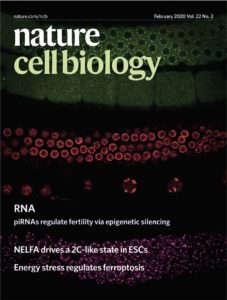 Transgenerational sterility caused by heritable small RNAs
Transgenerational sterility caused by heritable small RNAs
The results of our study illustrate how small non-coding RNAs can act as epigenetic molecules capable of transmitting traits across generation, over and above the information encoded in our genomes. Using the nematode Caenorhabditis elegans we show that the inheritance of small RNAs antisense to histone genes adversely affect the fertility of worms across generations until they become sterile.
Small-RNA-mediated transgenerational silencing of histone genes impairs fertility in piRNA mutants, Nature Cell Bio, 2020 Feb.
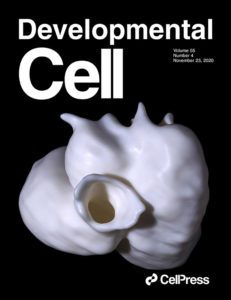 How Nodal helps shape the heart loop
How Nodal helps shape the heart loop
The secreted factor Nodal, known as a major left determinant, is associated with severe heart defects in the heterotaxy syndrome. Yet, it had remained unclear how it regulates asymmetric morphogenesis of the embryonic heart. Desgrange et al. report that Nodal is transiently active in precursors cells, before the formation of the embryonic heart tube. In conditional mouse mutants, we show that Nodal is not required to initiate asymmetric morphogenesis. Using 3D quantifications and simulations, we demonstrate that Nodal functions as a bias of heart tube looping: it is required to amplify and coordinate opposed left-right asymmetries at the heart tube poles, thus generating a robust helical shape. With the identification of downstream effectors of asymmetric Nodal signaling, our study is potentially relevant to other cases of asymmetric organogenesis.
Transient Nodal Signaling in Left Precursors Coordinates Opposed Asymmetries Shaping the Heart Loop, Dev Cell, 2020 Nov.
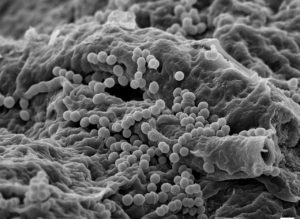 A new model to understand how pathogens breach the blood-brain barrier
A new model to understand how pathogens breach the blood-brain barrier
Brain infections are relatively rare but devastating. They arise when pathogenic microorganisms manage to breach the blood-brain barrier, a powerful chemical and physical filter made by the vascular walls. Using Drosophila, Benmimoun et al. developed an original model of brain infection offering ease and power of manipulation while respecting tissue structure. We then used this model to identify a novel mechanism of brain entry by Group B streptococcus, a pathogen responsible for meningitis in neonates.
An original infection model identifies host lipoprotein import as a route for blood-brain barrier crossing, Nature Comm, 2020 Nov.
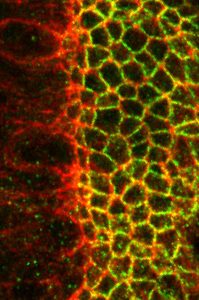 Neuralized, a critical regulator of tissue-wide EMT-like process
Neuralized, a critical regulator of tissue-wide EMT-like process
Shard et al. show that the emergence of Neural Stem Cells in the fly visual system involves a progressive EMT-like process sweeping through the optic lobe neuroepithelium. Tissue-scale coordination of this process requires the down-regulation of the apical Crumbs polarity complex by Neuralized.
Tissue-wide coordination of epithelium-to-neural stem cell transition in the Drosophila optic lobe requires Neuralized, J Cell Biol, 2020 Nov.
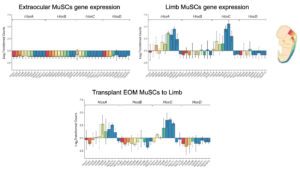 The transplantation of muscle stem cells modifies their transcriptome
The transplantation of muscle stem cells modifies their transcriptome
Adult skeletal muscles are regenerated upon injury by muscle stem cells (MuSCs). Intriguingly, MuSCs are heterogeneous in regulation and function, based on their anatomical location. Here we show that cranial and limb MuSCs have distinct transcriptome and DNA methylation signatures. Heterotopic transplantation of cranial MuSCs into the limb results in the cranial transcriptome being reprogrammed, yet about 10% of genes were resistant to alterations following transplantation, pointing to molecular determinants of regional identity. Our findings provide insights into strategies designed to improve the functional capacity of MuSCs in the context of regenerative medicine.
Transcriptome and epigenome diversity and plasticity of muscle stem cells following transplantation, PLoS Genet, 2020 Oct.

